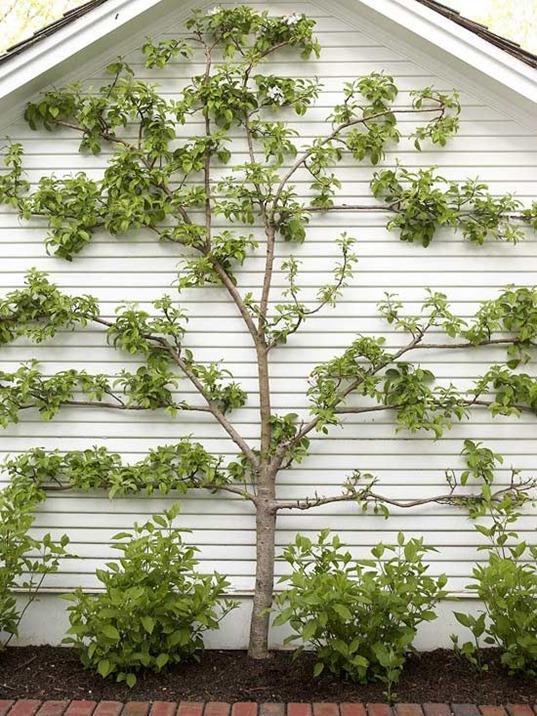I was pruning some bushes over the weekend and reminded how years ago I greened up our plain retaining wall with an invisible wire trellis, I wrote about it in one of my early blog posts. I planted bower vine and allow it to grow random and wild, only trimming it or tying it to the trellis when necessary to control it.
The trellis is constructed of wire and screw eyes and with the addition of bower vine has disguised the plainness of the wall, adding a welcome element of greenery. The leaves remain in winter and it blooms May through October with pink jasmine flowers.
I spied a similar wire trellis at my local Whole Foods, the technique used to achieve the same effect, this one constructed with diagonal wires instead of in a grid like mine.
It’s a simple construction, this one also used screw eyes secured to the wall and galvanized wire, and turnbuckles which allow you to tighten the screws and wires.
The wire trellis is an alternative to a structure you can purchase online or in a garden store, those are limited in shape and size and more expensive. The wires can be used to support any meandering vine as seen above or more formally by clipping and training vines into geometric patterns.
The art of espalier (pronounced es-pal-yay) is a favorite gardening technique for many people. It dates back many centuries, and was perfected by Europeans. Wineries and wine growers use a version of espalier to support grapevines, we also train our Pinot Noir vines each year, although less formally.
Whenever I see it in its most formal application I admire it very much because it takes patience and control, but the result is worth the wait, just like this tree I spied on a walk through Pacific Heights in San Francisco last year.
Espalier is the process of manipulating tree branches by forcing two dimensional growth along a constructed trellis on a single plane instead of allowing the branches to bloom outward in all directions.
There is a beauty to espalier but also a practicality, it is a clever way to add botanicals to tall walls or narrow outdoor spaces. The technique can also be used to create living fences or arbors as well.
source unknown
Fully trained, espalier trees are a focal point and work of art whether they’re ornamental or fruit bearing. It takes many years to train a tree and you can do it yourself with research, patience, and careful pruning or you can purchase an established espalier tree at a local nursery from specialist.
There are several defined types of espalier, the most recognizable is traditional horizontal Cordon.
espalier apple trees – horizontal cordon
The fan shape known as Palmette Oblique maintains a central stem and trains the branches on the diagonal, it works well for crabapple trees or trees with pits (cherries, nectarines, etc.)
The Palmette Verier allows for a middle branch then the offshoot branches are trained to grow horizontal then vertical in a fork shape.
A criss cross design is referred to as Belgian Fence and also takes careful training.
The informal style is just as beautiful, trained only to grow flat against the wall and nothing more.
better homes and gardens / source unknown
How have you trellised your vines in your yard, formally or informally? Have you ever tried espalier with success?
…
Green Walls: Trellised Vines + Espalier Trees is a post from Centsational Girl Republishing this article in full or in part is a violation of copyright law. © 2009-2015, all rights reserved.
The post Green Walls: Trellised Vines + Espalier Trees appeared first on Centsational Girl.














Walang komento:
Mag-post ng isang Komento